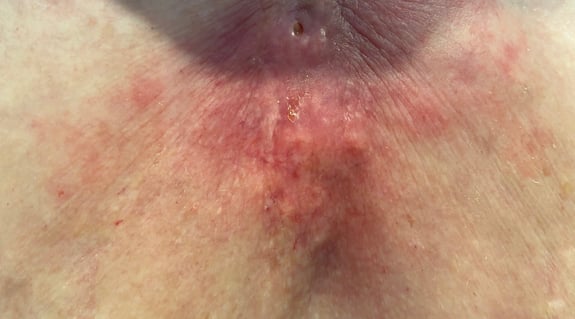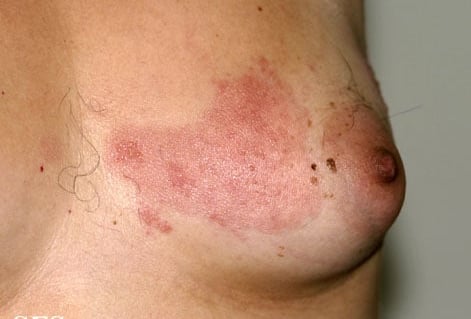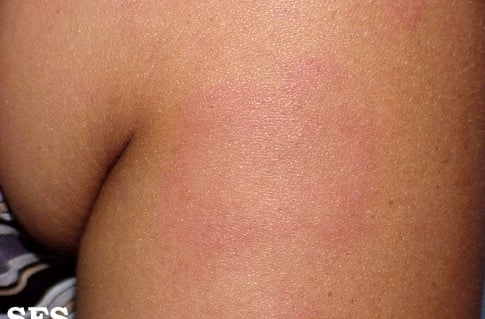4 professionals
Marguerite, 75 years old. Appearance of an erythematous plaque on the torso.
Marguerite, 75 years old. Appearance of an erythematous plaque on the torso.
Related topics
Marguerite, age 75, complains of the development of a clearly limited, slightly itchy, erythematous plaque on her torso, where she was treated 10 years ago for breast cancer (total mastectomy and radiotherapy).
She is not taking any medication and has not applied anything to her skin, as advised by her GP.
Clinically, there is atrophy and a network of telangiectasias in the area that was irradiated.

True answer!
Wrong answer!
True answer!
Wrong answer!
True answer!
Wrong answer!
True answer!
Wrong answer!
Late reactions are induced by inflammation followed by fibrosis or even necrosis.
Chronic radiodermatitis is responsible for reduced quality of life.
Chronic radiodermatitis is a highly polymorphic clinical condition. We may observe:
During the constitution phase, there may be no symptoms. Sometimes the area that has been irradiated develops chronic local inflammation with oedema, pruritus, or erythema.
This is followed by the organised sequelae phase, characterised by a non-inflammatory state with dry, itchy, hairless skin.
Finally, poikiloderma may develop with atrophy of the sclerotic subcutaneous tissues.
Telangiectasias may appear many years after the end of treatment. These telangiectasias are more frequent in cases of sun exposure.
The patient should be advised to avoid exposure to the sun for one year following treatment and to apply a high protection factor sunscreen.
Some misconceptions continue to circulate, wrongly, among the general public, such as:
Before treatment begins, the patient must be informed in advance, in appropriate terms, of the risks to which they will be exposed in the irradiated area of skin.
Explain the various possible clinical aspects of radiodermatitis and remind the patient that the onset may be delayed.
Explain that it is necessary to seek medical advice as soon as the first signs appear on the skin and that nothing should be applied without prior advice from a doctor. Many grade 1 or 2 radiodermatitis cases are aggravated by irritating topicals or corrosive substances used by patients trying to practise self-care.
Provide advice to limit the risk of radiodermatitis:
The irradiated area should be monitored to detect late-onset complications such as chronic radiodermatitis lesions, preepitheliomatous keratoses and skin carcinomas.
Skin monitoring must be continuous and lifelong.
Shingles presents as a unilateral, metameric eruption with radicular and vesicular topography (clusters of blisters filled with clear liquid on an erythematous base) associated with pain.

Allergic eczema progresses through four successive phases, which most often overlap:
The lesions are highly pruritic +++. They form eruptions with jagged contours.
Clinically, urticaria is defined by the appearance of highly pruritic papular skin lesions and/or fleeting, migrating mucosal lesions called plaques, sometimes associated with subcutaneous or mucous-membrane oedema called angioedema.


Remain in contact with the patient, particularly if you are responsible for her breast cancer treatment and for her preventive gynaecological care.
Provide pre- and post-radiotherapy advice over and above coordinating with the attending physician and take part in psycho-social and sexual health support relating to the cancer case.
Help the patient give up tobacco.

Recommend dermo-cosmetics that support healing with hyaluronic acid.
Advise the patient to see her radiation therapist regularly (every year for 5 years following the cancer).

Avoid irritating products.

Topical corticosteroids are preferred to give patients relief.
Critical point: Consider the possibility of chronic radiodermatitis, even years after radiotherapy.
Create easily your professional account
I create my accountGet access to exclusive dermatological services to increase your professionnal knowledge: +500 pathology visuals, clinical cases, expert videos
Benefit from valuable features: audio listening, materials to be shared with your patients
Stay informed about the upcoming events and webinars, latest scientific publications and product innovations